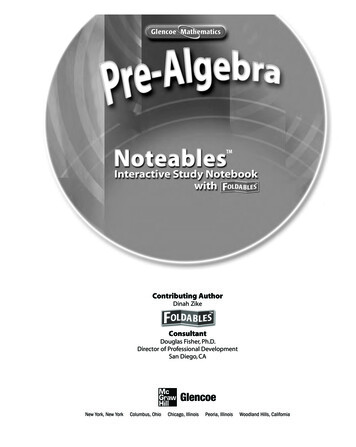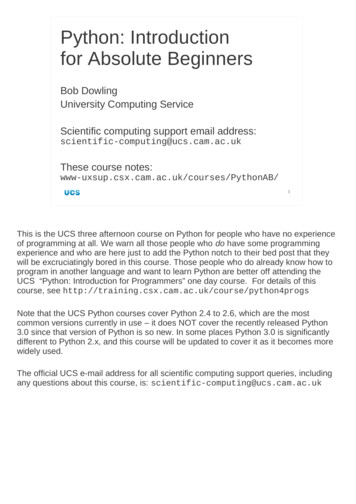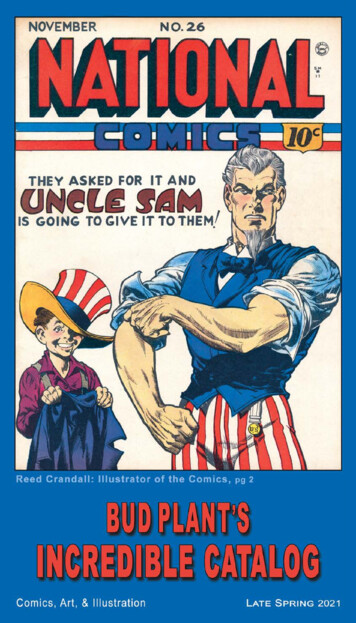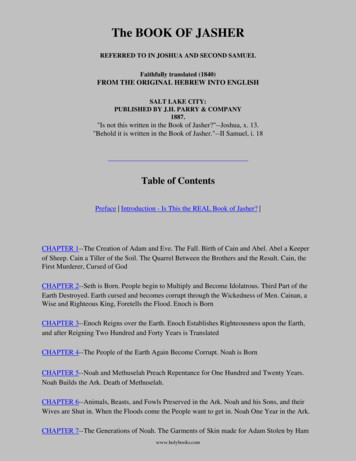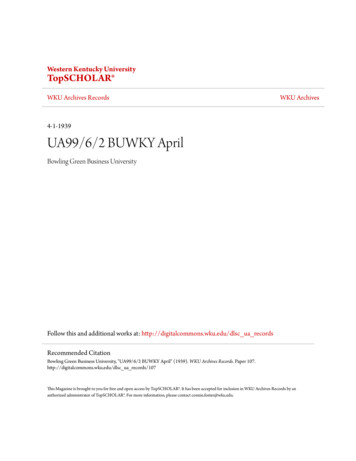
Transcription
AuthorDinah Zike, M. Ed.Educational ConsultantSan Antonio, Texas
Glencoe/McGraw-HillCopyright by The McGraw-Hill Companies, Inc. All rights reserved. Printed in the United Statesof America. Except as permitted under the United States Copyright Act, no part of this publicationmay be reproduced or distributed in any form or by any means, or stored in a database or retrievalsystem, without the prior written permission of the publisher.Send all inquiries to:Glencoe/McGraw-Hill8787 Orion PlaceColumbus, OH 43240Part of ISBN 0-07-830413-X1 2 3 4 5 6 7 8 9 1004511 10 09 08 07 06 05 04 03 02Teaching Mathematics with Foldables
Table of ContentsProjects Using FoldsBillboard Project . . . . . . . . . . . . . . . . . . . . .32Sentence-Strip Holder . . . . . . . . . . . . . . . . .33Sentence Strips . . . . . . . . . . . . . . . . . . . . . .34Letter from Dinah Zike . . . . . . . . . . . . . . . . . . . . .vIntroduction to FoldablesWhy Use Foldables in Mathematics? . . . . . .viCorrelation of Foldables toGlencoe Mathematics . . . . . . . . . . . . . . . .viiFoldable Basics . . . . . . . . . . . . . . . . . . . . . . .1Selecting the Appropriate Foldable . . . . . . . .3Math Activities using FoldablesNumber SystemsWhole Numbers . . . . . . . . . . . . . . . . . . . . . .35Integers . . . . . . . . . . . . . . . . . . . . . . . . . . . .36Integers: Adding and Subtracting . . . . . . . . .37Integers: Multiplying and Dividing . . . . . . .38Rational Numbers . . . . . . . . . . . . . . . . . . . .39Rational Numbers: Fractions . . . . . . . . . . . .40Rational Numbers: Decimals . . . . . . . . . . . .41Percents . . . . . . . . . . . . . . . . . . . . . . . . . . . .42Ratios . . . . . . . . . . . . . . . . . . . . . . . . . . . . .43Proportions . . . . . . . . . . . . . . . . . . . . . . . . .43Irrational Numbers . . . . . . . . . . . . . . . . . . . .44Real Number System . . . . . . . . . . . . . . . . . .44Folding InstructionsBasic Foldable Shapes . . . . . . . . . . . . . . . . . . . . . .51-Part FoldsHalf Book . . . . . . . . . . . . . . . . . . . . . . . . . . .6Folded Book . . . . . . . . . . . . . . . . . . . . . . . . .7Bound Book . . . . . . . . . . . . . . . . . . . . . . . . .8Two-Tab Book . . . . . . . . . . . . . . . . . . . . . . . .92-Part FoldsMatchbook . . . . . . . . . . . . . . . . . . . . . . . . .10Pocket Book . . . . . . . . . . . . . . . . . . . . . . . .11Shutter Fold . . . . . . . . . . . . . . . . . . . . . . . . .12Algebraic Patterns and FunctionsSets and Variables . . . . . . . . . . . . . . . . . . . .45Expressions . . . . . . . . . . . . . . . . . . . . . . . . .46Properties . . . . . . . . . . . . . . . . . . . . . . . . . .47Equations . . . . . . . . . . . . . . . . . . . . . . . . . . .48Inequalities . . . . . . . . . . . . . . . . . . . . . . . . .49Relations and Functions . . . . . . . . . . . . . . . .50Factors . . . . . . . . . . . . . . . . . . . . . . . . . . . . .51Multiples . . . . . . . . . . . . . . . . . . . . . . . . . . .52Monomials and Polynomials . . . . . . . . . . . .53Powers and Exponents . . . . . . . . . . . . . . . . .54Sequences . . . . . . . . . . . . . . . . . . . . . . . . . .55Matrices . . . . . . . . . . . . . . . . . . . . . . . . . . .563-Part FoldsTrifold Book . . . . . . . . . . . . . . . . . . . . . . . .13Three-Tab Book . . . . . . . . . . . . . . . . . . . . . .14Three-Tab Book Variations . . . . . . . . . . . . .15Pyramid Fold or Mobile . . . . . . . . . . . . . . . .164-Part FoldsLayered-Look Book . . . . . . . . . . . . . . . . . . .17Four-Tab Book . . . . . . . . . . . . . . . . . . . . . .18Envelope Fold . . . . . . . . . . . . . . . . . . . . . . .19Standing Cube . . . . . . . . . . . . . . . . . . . . . . .20Four-Door Book . . . . . . . . . . . . . . . . . . . . .21Top-Tab Book . . . . . . . . . . . . . . . . . . . . . . .22Accordion Book . . . . . . . . . . . . . . . . . . . . .24GeometryPoints . . . . . . . . . . . . . . . . . . . . . . . . . . . . .57Lines and Line Segments . . . . . . . . . . . . . . .57Rays . . . . . . . . . . . . . . . . . . . . . . . . . . . . . .57Angles . . . . . . . . . . . . . . . . . . . . . . . . . . . . .58Angle Relationships . . . . . . . . . . . . . . . . . . .58Planes . . . . . . . . . . . . . . . . . . . . . . . . . . . . .59Polygons . . . . . . . . . . . . . . . . . . . . . . . . . . .60Triangles . . . . . . . . . . . . . . . . . . . . . . . . . . .61Right Triangles . . . . . . . . . . . . . . . . . . . . . .62Right Triangle Trigonometry . . . . . . . . . . . .63Any Number of PartsPop-Up Book . . . . . . . . . . . . . . . . . . . . . . . .25Folding into Fifths . . . . . . . . . . . . . . . . . . . .26Folded Table, Chart, or Graph . . . . . . . . . . .27Folding a Circle into Tenths . . . . . . . . . . . . .28Circle Graph . . . . . . . . . . . . . . . . . . . . . . . .29Concept-Map Book . . . . . . . . . . . . . . . . . . .30Vocabulary Book . . . . . . . . . . . . . . . . . . . . .31 Glencoe/McGraw-HilliiiTeaching Mathematics with Foldables
Permutations . . . . . . . . . . . . . . . . . . . . . . . .81Combinations . . . . . . . . . . . . . . . . . . . . . . .81Probability . . . . . . . . . . . . . . . . . . . . . . . . . .82Scatter Plots . . . . . . . . . . . . . . . . . . . . . . . . .83Quadrilaterals . . . . . . . . . . . . . . . . . . . . . . .64Squares, Rectangles, and Rhombi . . . . . . . .65Parallelograms . . . . . . . . . . . . . . . . . . . . . . .66Trapezoids . . . . . . . . . . . . . . . . . . . . . . . . . .67Circles . . . . . . . . . . . . . . . . . . . . . . . . . . . . .68Three-Dimensional Figures . . . . . . . . . . . . .69Prisms and Cylinders . . . . . . . . . . . . . . . . . .70Pyramids and Cones . . . . . . . . . . . . . . . . . .71Coordinate Geometry . . . . . . . . . . . . . . . . . .72Slope . . . . . . . . . . . . . . . . . . . . . . . . . . . . . .73Graphing Equations and Inequalities . . . . . .74Problem SolvingProblem-Solving Plan . . . . . . . . . . . . . . . . .84Problem-Solving Strategies . . . . . . . . . . . . .84CommunicationVocabulary and Writing Definitions . . . . . . 85Journals . . . . . . . . . . . . . . . . . . . . . . . . . . . .85Outline, List, and Sequence . . . . . . . . . . . . .86Concept Maps . . . . . . . . . . . . . . . . . . . . . . .86Writing Instructions . . . . . . . . . . . . . . . . . . .86Main Ideas and Note Taking . . . . . . . . . . . .87Annotations . . . . . . . . . . . . . . . . . . . . . . . . .87Questioning . . . . . . . . . . . . . . . . . . . . . . . . .87MeasurementMetric Measurement . . . . . . . . . . . . . . . . . .75Length, Width, and Height . . . . . . . . . . . . . .75Distance . . . . . . . . . . . . . . . . . . . . . . . . . . .76Weight . . . . . . . . . . . . . . . . . . . . . . . . . . . . .76Volume . . . . . . . . . . . . . . . . . . . . . . . . . . . .77Temperature . . . . . . . . . . . . . . . . . . . . . . . . .77RepresentationTables and Charts . . . . . . . . . . . . . . . . . . . .88Circle Graphs . . . . . . . . . . . . . . . . . . . . . . .88Bar Graphs and Histograms . . . . . . . . . . . . .89Line Graphs . . . . . . . . . . . . . . . . . . . . . . . . .89Pictographs . . . . . . . . . . . . . . . . . . . . . . . . .90Venn Diagrams . . . . . . . . . . . . . . . . . . . . . .90Data Analysis and ProbabilityStatistics . . . . . . . . . . . . . . . . . . . . . . . . . . .78Stem-and-Leaf Plots . . . . . . . . . . . . . . . . . .79Box-and-Whisker Plots . . . . . . . . . . . . . . . .79Fundamental Counting Principle . . . . . . . . .80Frequency Tables . . . . . . . . . . . . . . . . . . . . .80Pascal’s Triangle . . . . . . . . . . . . . . . . . . . . .80 Glencoe/McGraw-HillIndex . . . . . . . . . . . . . . . . . . . . . . . . . . . . . . . . . . . . .91ivTeaching Mathematics with Foldables
FROM DINAH ZIKEDear Teacher,In this book, you will find instructions for making Foldables as well as ideas on how to usethem. They are an excellent communication tool for students and teachers.National Math Standardsand Communication SkillsThe Principles and Standards for School Mathematics, published by the NationalCouncil of Teachers of Mathematics (NCTM) in 2000, stress the importance ofcommunication skills in a strong mathematics program. Not all students willbecome mathematicians, engineers, or statisticians, but all students need to be ableto think, analyze, and problem solve using skills acquired through the study ofmathematics.Throughout their lives, students will be called upon to be literate in mathematics—personally and professionally. They will need to have a basic understanding ofnumbers, operations, and quantitative reasoning; patterns, relationships, andalgebraic thinking; geometry; measurement; and probability and statistics to solvereal-life problems involving finances, chance, design, science, fine arts, and more.Furthermore, students must be able to share the results of their use of mathematicsusing various forms of oral and written communication. Foldables are one of manytechniques that can be used to integrate reading, writing, thinking, organizing data,researching, and other communication skills into an interdisciplinary mathematicscurriculum.Who, What, When, WhyYou probably have seen at least one of the Foldables featured in this book used insupplemental programs or staff-deveopment workshops. Today, my Foldables areused internationally. I present workshops and keynotes to over fifty thousandteachers and parents a year, sharing the Foldables that I began inventing, designing, and adapting over thirty years ago. Around the world, students of all ages areusing them for daily work, note-taking activities, student-directed projects, formsof alternative assessment, math journals, graphs, charts, tables, and more.Add and AmendAfter workshop presentations, participants would ask me for lists of activities to beused with the Foldables they had just learned to make. They needed help visualizinghow to convert math data into Foldables. So, over fifteen years ago, I began collecting and sharing the ideas listed in this book. The ideas are organized by topic. Thetable for each topic shows the math content being addressed and an appropriateFoldable. I hope you enjoy making Foldables a part of your math classroom! Glencoe/McGraw-HillvTeaching Mathematics with Foldables
INTRODUCTION TO FOLDABLESWhy Use Foldables in Mathematics?When teachers ask me why they should take time to use the Foldables featured in this book, Iexplain that they. . . quickly organize, display, and arrange information, making it easier for students to graspmath concepts and master skills. . . result in student-made study guides that are compiled as students listen for main ideas,read for main ideas, and work their way through new concepts and procedures. . . provide a multitude of creative formats in which students can present projects, research,and computations instead of typical poster board or math fair formats. . . replace teacher-generated writing or photocopied sheets with student-generated print. . . incorporate the use of such skills as comparing and contrasting, recognizing cause andeffect, and finding similarities and differences into daily work and long-term projects. Forexample, these Foldables can be used to compare and contrast student explanations andprocedures for solving problems to the explanations presented by other students andteachers. . . continue to “immerse” students in previously learned vocabulary and concepts, providingthem with a strong foundation that they can build upon with new observations,experiences, and knowledge. . . can be used by students or teachers to easily communicate data through graphs, tables,charts, models, and diagrams, including Venn diagrams. . . allow students to make their own math journals for recording main ideas, problem-solvingstrategies, examples, questions that arise during classwork, and personal experiences thatoccur during learning. . . can be used as alternative assessment tools by teachers to evaluate student progress or bystudents to evaluate their own progress. . . integrate language arts, the sciences, and social sciences into the study of mathematics. . . provide a sense of student ownership in the mathematics curriculum. Glencoe/McGraw-HillviTeaching Mathematics with Foldables
INTRODUCTION TO FOLDABLESCorrelation of FoldablesTM to Glencoe MathematicsFoldableTM TopicNumber SystemsWhole NumbersIntegersIntegers: Addingand SubtractingIntegers: Multiplyingand DividingRational NumbersRational Numbers:FractionsRational l NumbersReal Number SystemPatterns and FunctionsSets and sRelations andFunctionsFactorsMultiplesMonomials andPolynomialsPowers and ExponentsSequencesMatricesGeometryPointsLines and LineSegmentsRaysAnglesAngle RelationshipsPlanesPolygonsTrianglesRight Triangles tics:Applications and Applications and Applications andPre-Algebra Algebra 1 Geometry Algebra 2Connections,Connections,Connections,Course 1Course 2Course 3 vii Teaching Mathematics with Foldables
INTRODUCTION TO FOLDABLESCorrelation of FoldablesTM to Glencoe MathematicsFoldableTM ons and Applications and Applications andPre-Algebra Algebra 1 Geometry Algebra 2Connections,Connections,Connections,Course 1Course 2Course 3Algebra and RightTrianglesQuadrilateralsSquares, Rectangles,and onalFiguresPrisms and CylindersPyramids and ConesCoordinate GeometrySlopeGraphing Equationsand InequalitiesMeasurementMetric MeasurementLength, Width, andHeightDistanceWeightVolumeTemperatureData Analysis and ProbabilityStatisticsStem-and-Leaf PlotsBox-and-Whisker PlotsFundamental CountingPrincipleFrequency TablesPascal’s TrianglePermutationsCombinationsProbabilityScatter PlotsProblem SolvingProblem Solving PlanProblem SolvingStrategiesCommunicationVocabulary and WritingDefinitions Glencoe/McGraw-Hill viii Teaching Mathematics with Foldables
INTRODUCTION TO FOLDABLESCorrelation of FoldablesTM to Glencoe MathematicsFoldableTM TopicJournalsOutline, List, andSequenceConcept MapWriting InstructionsMain Ideas and es and ChartsCircle GraphsBar Graphs andHistogramsLine GraphsPictographsVenn diagrams tics:Applications and Applications and Applications andPre-Algebra Algebra 1 Geometry Algebra 2Connections,Connections,Connections,Course 1Course 2Course 3 ixTeaching Mathematics with Foldables
INTRODUCTION TO FOLDABLESFoldable BasicsWhat to Write and WhereTeach students to write general information—titles, vocabulary words, concepts, questions, mainideas, and properties or theorems—on the front tabs of their Foldables. General information isviewed every time a student looks at a Foldable. Foldables help students focus on and rememberkey points without being distracted by other print.Ask students to write specific information—supporting ideas, student thoughts, answers toquestions, research information, computation steps, class notes, observations, and definitions—under the tabs.As you teach, demonstrate different ways inwhich Foldables can be used. Soon you will findthat students make their own Foldables and usethem independently for study guides and projects.With or Without TabsFoldables with flaps or tabs create study guides that students can use to self check what theyknow about the general information on the front of the tabs. Use Foldables without tabs forassessment purposes or projects where information is presented for others to view quickly.Venn Diagram used as a study guide Glencoe/McGraw-Hill1Venn Diagram used for assessmentTeaching Mathematics with Foldables
INTRODUCTION TO FOLDABLESWhat to Do withScissors and GlueI don’t expect secondary students to bringglue and scissors to math class. Instead, Iset up a small table in the classroom andprovide several containers of glue,numerous pairs of scissors (sometimes tiedto the table), containers of markers andcolored pencils, a stapler, clear tape, andanything else I think students might needto make their Foldables. Don’t besurprised if students donate unusualmarkers, decorative-edged scissors, gelpens, stencils, and other art items to your publishing table.The more they make and use graphic organizers, the faster students become atproducing them.Storing GraphicOrganizers inStudent PortfoliosTurn one-gallon freezer bags into studentportfolios which can be collected andstored in the classroom. Students can alsocarry their portfolios in their notebooks ifthey place strips of two-inch clear tapealong one side and punch three holesthrough the taped edge.Have each student write his or her namealong the top of the plastic portfolio with apermanent marker and cover the writing with two-inch clear tape to keep it from wearing off.Cut the bottom corners off the bag so it won’t hold air and will stack and store easily.HINT: I found it more convenient to keep student portfolios in my classroom sostudent work was always available when needed and not “left at home” or “inthe car.” Giant laundry-soap boxes make good storage containers for portfolios.Let Students Use This Book As an Idea ReferenceMake this book available to students to use as an idea reference for projects, discussions, extracredit work, cooperative learning group presentations, and more. Glencoe/McGraw-Hill2Teaching Mathematics with Foldables
INTRODUCTION TO FOLDABLESSelecting the Appropriate FoldableDividing Math Concepts into PartsFoldables divide information and make it visual. In order to select the appropriate Foldable,decide how many parts you want to divide the information into and then determine whichFoldable best illustrates or fits those parts. Foldables that are three-dimensional also make thestudent interact with the information kinesthetically.For example, if you are studying the Properties of Equality you could choose a Foldable thathas five tabs (or sections). On the front tabs write the properties. Under the tabs, explain theproperties in words on one side and in symbols on the other side.Math Concepts Already Divided into PartsParts53AlgebraConceptPr
You probably have seen at least one of the Foldables featured in this book used in supplemental programs or staff-deveopment workshops. Today, my Foldables are used internationally. I present workshops and keynotes to over fifty thousand teachers and parents a year, sharing the Foldables that I began inventing, design-

